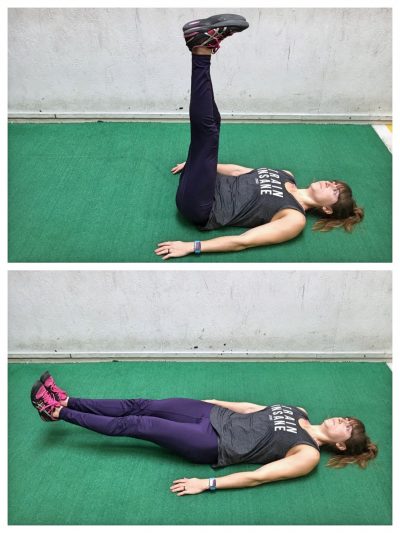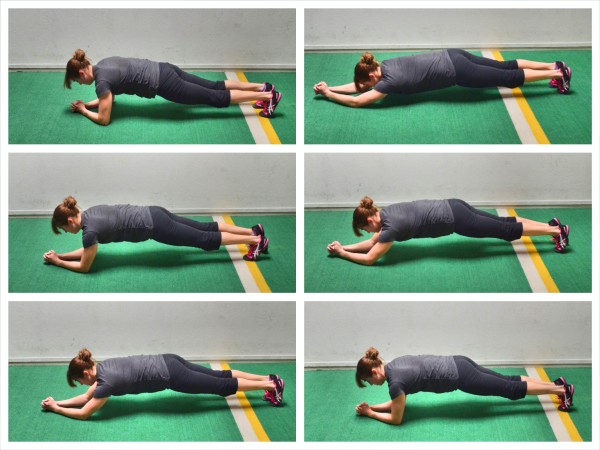GASP! Maybe there is something to this LOWER AB thing!
Fitness elitists will get really mad if you utter the term “lower abs.”
Because technically there is no lower ab muscle.
Technically it is all the same muscle the rectus abdominis that we are usually targeting with our core work, especially if we want six pack abs.
(I’ve had to turn away when another trainer tries to lecture me on using the term lower abs to secretly roll my eyes. I guess I could lecture them back…but why?)
Anyway…
All those “lower ab moves” we used to use started to get written off as simply hip flexor exercises since most of those moves done for lower abs include leg lower type movements.

And yes…your hip flexors DO work during those leg lowers.
But I just couldn’t fully accept that they had no impact on the “lower abs.”
My “lower ab” definition was best when doing more leg lower movements after learning the pelvic tilt and after doing hanging abs.
I felt the lower ab region really WORKING during those moves and I’m always extra conscious when testing movements to feel WHERE is activating.
Because guess what? Doing the right moves even without feeling the correct muscles working is going to do NOTHING except put you at risk for injury!
So feeling my “lower abs” working led me to include hanging abs and the posterior pelvic tilt in my Killer Core program.
If you feel the muscles activating, and have clients agree with those finding and feel their “lower abs” like never before, SOMETHING is going on.
So that led me to hours of pouring over studies trying to see if I could figure out what I, and my clients, were feeling.
Were we simply mistaking this feeling in our “lower abs” for our psoas working?
That’s when I found studies showing that different ab exercises DID, in fact, activate portions of the URA and LRA (upper and lower rectus abdominis) to different extents. (Study 1)
Which frankly makes sense considering we’ve shown, and even more widely accept, that exercises activate upper or lower pec fibers differently and even upper and lower glute max fibers differently.
Another interesting results I found in a study was that POSTERIOR PELVIC TILT actually had HIGHER LRA for groups that learned to perform it correctly and were even more active AKA all of us who’ve trained a lot and are looking for that true engagement! (Study 2)
This also made me realize how important it was to correctly teach the posterior pelvic tilt progression – a progression we often skip to jump right to the hardest leg lower move.
Ever feel your lower back taking over during leg lowers? Ever put your hands behind your lower back to correct this?
Well this is just putting a bandaid on the problem. This is why we end up only working our hips and quads, and maybe even lower backs, with these moves.
It’s why we DON’T work our lower abs to the extent these moves can work them.
When you want to work your lower abs, you need to focus on what is working. REGRESS the posterior pelvic tilt progression to maybe a single leg lower or bent knee march or even just a simple HOLD.
But regress until you can properly feel your abs working and then slowly progress!

Ok so maybe you’re now thinking “I buy the whole activating different aspects of the muscles, BUT leg raise movements are STILL hip flexor moves….”
Well guess what!?!
Hanging Leg Raises actually have the highest mean AND peak activation of the rectus abdominis! (Oh and this article not only confirms that but also the existence of differences in activation between the Upper and Lower RA!)
I would say it looks like my abs are working pretty hard here…as well as some other important muscles of my core!

So for you that are non-believers adamantly against any leg raise type movement who annoyingly try to correct anyone who even utters the words Lower Abs, just be open to the differences in activation!
And also realize that part of what makes a difference is what you force your body to feel working and how you even cue and coach the moves. Just like the double leg lowers…You sometimes need to regress to progress.
It may mean starting with a Hanging Pelvic Tilt to learn how to engage the abs to then help assist in the Hanging Leg Raises. Or it may be doing a bent knee raise to start. But the key is being conscious of what is working as you utilize these moves!

I almost feel like this adamant “there are no lower abs” makes us cut off our noses to spite our faces.
Why miss out on moves that can only HELP!?!
Don’t miss out on using these moves because the term we use is referring to a region of a muscle not a separate muscle.
Hanging Leg Raises, Pelvic Tilt…oh and even the Body Saw (a study also showed a longer lever plank like the Body Saw was great for the core!) are KILLER ab moves you NEED to be including!

Let’s not miss chances to get the results we want when we can FEEL something working!
It’s also another reason to THINK about what you actually feel working and constantly assess your recruitment patterns!
So take some time today and test out those moves!
Ready to work not only your LOWER ABS but your entire core?
Ready to implement some Hanging Abs, Pelvic Tilt and even long lever planks into your routine?
Start the 30-Day Killer Core Challenge! All you need is your own bodyweight and a bar!



I really appreciate your time and effort in helping to get the truth out because this is an area I am really struggling with. Now I know what I need to do. Thanks so much!!!!
Glad it helps!
Thanks for this. You explain things well! I have studied what you are talking about with Paul Chek. Have you taken his courses?If so which ones would you recommend? I wonder if you can direct me to further studies as am a personal trainer and massage therapist and want to learn more!! Thanks
Just awesome! ♡
Fitness is so involving so quickly.. it’s sometimes hard to keep up with the next best thing. Refreshing knowledge is crucial in connecting with our broad range of clients needs and goal.
You are so helpful Cori. You bring so much content that is current and valuable, not to mention inspirational – into our lives in order for us to grow and learn better ways of delivering what we already have regurgitated probably once or twice already over a period of time…years! But, you’re awesome Cori.. love what you bring us. Keep up the hard work. No1 fan ♡
Thanks Teresa! Definitely try to keep up with everything and share what I learn! 🙂
This is why I love you.
🙂
Ditto what Teresa said, #2 fan!
I find that people can perform the supine heel touch (I do not teach it reciprocally at first) maintaining the posterior pelvic tilt on the lowering phase but maintaining the level of control of the posterior pelvic tilt as the leg comes up is so much harder. Only when they can master the control throughout the move will I move to the march progression. And only then to the single straight leg lowering. Not many of the folks I work with can maintain the pelvic tilt with both legs lowering yet I observe it being taught in many classes.
Thanks for your time in research for the ‘proof’. The whole no lower abd training was a puzzler to me and I knew that the way I was teaching was correct!!
hehe thanks Jessica!
So glad you’re helping clients regress to progress and really be intentional with the movements!
Late to the conversation here, but what a great post! I’ve been teaching Pilates and restorative work for nearly 10 years, but didn’t know until just recently that “low abs” is a disdainful phrase in the fitness world, now it’s all I see, and I was like, “Are you even kidding me? This is a THING?” So I hit the internet and found your post! Your explanation is so thorough and thoughtful, and confirms everything I’ve learned as a restorative movement teacher, as well as with my own anecdotal experiences and observations. Thanks so much for taking the time to articulate this so well! I’m going to go practice my reciprocal eye roll now! lol
I’m so glad it helped! And honestly…I wish we saw so much more value in NUANCE when it comes to diet and exercise. Because it is in that nuance that we often find tweaks that help us not only achieve results but meet our clients where they are at!